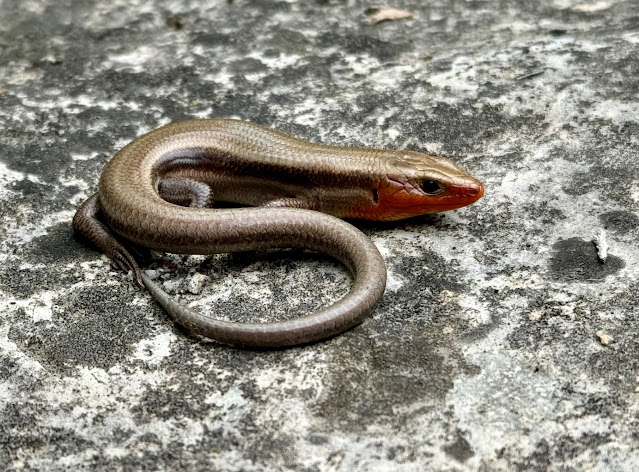Conveniently located along the Bible Belt (pause added for effect), the Ozarks is one of the most awe inspiring physiographic regions in the United States. It contains some of the oldest landforms in the country and is home to an astounding number of plant and animal species. Its rocky glades and cool forests beckon the adventurer. I was fortunate to spend a weekend exploring the southern portion of the Salem Plateau in Missouri with Peter Paplanus and the experience was nothing short of revitalizing.
I agreed to meet Peter at his house but hiked a local trail while waiting for him to arrive. Carefully scrambling along a steep riverbank lined in discarded slabs of concrete, I found a common gartersnake (Thamnophis sirtalis) here. When I saw Peter minutes later, I jokingly bid him adieu as I had met my quota. In all seriousness, the trip had only begun.
We headed southwest from St. Louis toward our destination and figured that since we had a couple of hours’ worth of daylight left, we’d stop at a glade to search for snakes before continuing our journey under the cover of darkness. It was a good decision on Peter’s part as the view from atop the glade was amazing. We also found a few nice snakes. On the way there, while driving up a curved narrow road through some open woodlands, a dead carcass fell out of the sky about ten feet in front of my car, followed by the large golden eagle that dropped it. Apparently the bird was having some difficulty gaining altitude with what Peter thought was a large rabbit. It flew to a tree and perched there, likely waiting for the coast to clear before returning to its victim.
After being turned away from a couple of hotels in the area, I found a locally owned place that had room for two rough looking scoundrels. Walking into the lobby, we were surrounded in Biblical quotes, crucifixes, and lots of other symbols both from the Old and the New Testament. It’s important to note that we were the youngest tenants by at least several decades. Our room was fairly nondescript except for a well-used and proudly propped copy of the “Cowboy Bible”.
We got up very early the next morning and made our way to the first site. With temperatures in the mid forties I was not hopeful, but Peter assured me we’d be successful. We were joined by Peter’s friend Greg, a local who had years of experience in these areas. Pete was right - it didn’t take long before we began finding reptiles here. A good variety of lizards and snakes were represented.
Greg and Peter suggested that we move to a nearby site for a chance at finding the variable ground snake (Sonora episcopa). A long hike through a mature deciduous woodland brought us to an isolated glade teeming with reptiles. By now the temperature had risen to about sixty-four degrees F.
Our next and final location was about a thirty minute drive away. A small but intact section of glades that produced even more species and a vista complete with a waning westerly sun and a cool breeze to signal an end to the trip.
.jpg)
.jpg)










.jpg)
.jpg)



.jpg)




.jpg)

























.jpg)





